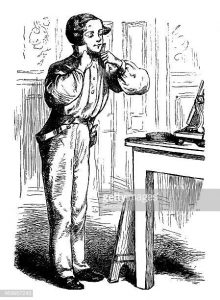
A smart young Victorian man doing up his collar and looking pleased. From “Stories For The Household” by Hans Christian Andersen. Illustrations by A.W. Bayes; engravings by Dalziel brothers. Published by George Routledge & Sons Ltd of London, Glasgow, Manchester and New York in 1891.
Dec 18, 2019–I resent how much effort it takes to get dressed every morning.
Pull on undershorts.
Pull on undershirt.
Pull on one sock. Pull on the other (hopefully, matching) sock.
Pull on pants.
Put on shirt.
Pull on shoes.
Then the fastening begins:
Fasten 6 buttons on a shirt, plus 2 on the cuffs and 2 on the collar.
Zip and button up pants.
Tighten and tie 2 shoestrings.
If you wear a tie, there is further threading and another knot.
That’s a dozen separate steps, and doesn’t even count getting into jackets, hats, and outerwear.
This is for the simple, non-fashion model male. The woman’s routine is even more arduous, involving foundation garments with various inserts, and synthetic fabrics patented to constrict and shape.
I remember seeing the first children’s shoes that replaced shoestrings with Velcro closures, and I predicted the demise of western civilization. But strings still bind in the garment industry. It is reassuring that a basic knowledge of knots is still required for us to leave the house wearing shoes.
When watching one of those Victorian dramas on the latest movie-delivery streaming system, we chuckle at the various fashions sported by denizens of the era. Just look at those fluffy shirts and starched collars, shoes with buckles, knee-high hose with tassels, and a hardware store of fasteners, hooks and eyes, flamboyant bows, and endless lacing. And layer upon layer of undergarments, designed I surmise to discourage access to skin. How droll, we smirk. Why did they put up with such arcane dictates of a fashion that required powdering wigs and whale-boning corsets?
Yet we haven’t really left behind cumbersome fashion. You’d think by this era, mankind would come closer to donning the streamlined garb we were promised in those 1950s sci-fi movies, where everyone dressed alike in silvery one-piece jumpsuits.
The closest I’ve experienced to that ideal is when I worked at a turkey hatchery in high school. One day the suits at corporate headquarters decided all crew members would wear a one-piece white coverall.
I actually loved it. Simple. Step in, zip up from crotch to chin. Nor did I need to decide what to wear each day, an added bonus for me, who could never learn the mysterious rules of “matching” that my older sisters tried to impart.
So why do we still follow fashion, no matter how impractical? I have a theory, which I will attempt to explain without violating today’s rules of gender sensitive discourse, which is another field I lack training in.
I took a ballet class in college. Three days a week I was the only male in a mirrored room filled with women in uniformly black tights and leotards. We could all see each other’s physical attributes, along with our flaws. There was nothing remotely provocative about it. That might have been because we were all contorting our limbs, trying to understand French ballet terms, and getting yelled at by a Russian instructor about our sickle feet.
Yet after class, when I glimpsed the coeds leaving the building in their street clothes, I found myself naturally aware of their individual handsomeness. Somehow, draping our bodies in tasteful colors and fabrics enhanced the attributes of the actual bodies I’d just spent an unremarkable hour sweating alongside.
I guess that’s why we continue our little hopping dances and contortionist exercises zipping, buttoning, and Velcro-ing ourselves into the latest fashions.
It’s not the present; it’s the package.